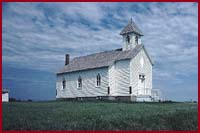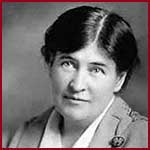 |
 |
 |
|
|||
|
Willa Cather's Red Cloud, Nebraska Even if it's been a while since you've read Willa Cather, being in Nebraska has a way of making you feel like you remember every detail of her books. That goes even more so for the tiny town of Red Cloud, which occupies a stretch of land between the Republican and Little Blue rivers known to the first settlers as "The Divide". This was Cather's home and, more importantly, her geographical muse. Today it's known simply as Catherland. 
Willa Cather's family left Virginia to homestead in Nebraska in 1882 and Red Cloud is featured in six of her 12 novels. In O Pioneers, Red Cloud is called Hanover. In My Ántonia, it goes by Black Hawk. In her novel The Song of the Lark, Red Cloud is the prototype for a small Colorado town called Moonstone. Today, in the restored bank building on Webster Avenue, a visitor looking at a reproduction of the painting that inspired the title for The Song of the Lark cannot stop herself from reading Cather's prose out loud.
Barbara: "She liked even the name of it, The Song of the Lark. The flat country, the early morning light, the look in the girl's heavy face. Well, they were all hers anyhow. She told herself that that picture was right. Just what she meant by this it would take a clever person to explain. But to her the word covered the almost boundless satisfaction she felt when she looked at the picture. As I was driving here, there's a little dip and there were trees on both sides of the highway as we were coming into Red Cloud and I thought, 'Oh, what a wonderful little spot.' And now that I think of it, it was right. Just like, I'm gonna have to remember that word." Barbara Loyd is a teacher from Kansas. She's come to Red Cloud with her friend Karen Griffiths, an attorney, because their book club is reading Willa Cather.
Karen: "Every summer we talked about going to see the Willa Cather Foundation and her family home, so I organized this Saturday for the trip for the ladies' book club from Norton, Kansas. I guess men can join but we haven't had any." It's so hot this weekend, the thermometer at the Webster County People's Bank is reading 103 degrees, that not only are Barbara and Karen the only members of their book club who made it, they're the only ones taking the tour this afternoon.
Katy: "Red Cloud is two blocks long. It was founded in 1872 and Willa Cather came here when she was between nine and 10 years old in the early 1880s. She lived here until she went to the university in Lincoln. We're going to go now down our main street along and across you can see the corner, where now is a grocery store." Katy Cardinal, a tour guide for the Cather Society, describes the historical and literary significance of each site with an attention to detail that sometimes seems worthy of a doctoral thesis. 
Katy: "That used to be the general merchandise store, one of the buildings that's featured in My Ántonia. If you're familiar with My Ántonia, they talk about the Harling family. The real family that was in Red Cloud was named the Miners. That corner also is mentioned in O Pioneers. Do you remember the part where the boy goes up the telephone poll to save the kitten?" Though it would seem that every square foot of downtown Red Cloud can be traced back to a Willa Cather novel or short story, the books really come to life inside the house where Willa spend most of her childhood. Though it's surrounded by ordinary houses where ordinary families live, the very same bittersweet vine that bloomed when the Cathers lived there climbs up the porch today
Katy: "It's been restored to its original look and even the paint chips were sampled to see that the color was correct. The house itself was mentioned in the novel The Song of the Lark and in two short stories "Old Mrs. Harris" and "The Best Years". In The Song of the Lark, it talks about the heroine, Thea Kronborg, stretched out on the lounge bed and how she counts the roses in the Belgian carpet, so you can see how close they've come to doing the house here for the state historical society." Both Barbara Loyd and Karen Griffiths, the book clubbers from Kansas, say the pleasures of Catherland have a lot to do with the painstaking details of both Cather's writing and the restoration of the sites. When you visit the Cather home you feel like you're actually in a Cather book. For a moment or two, you might even feel like an actual pioneer.
Karen: "When you read her, you really connect with the land. Growing up I would never read Willa Cather because I saw it as flat boring land she's going to tell me about. But when you read her you just really appreciate Nebraska and pioneering probably and what it took, but you also appreciate the simple things." Sometimes the idea of visiting a historic literary site can be a bit off-putting, especially when you haven't exactly read all of the author's works. But what's unique about Red Cloud is the way it shows you Cather the historian as well as Cather the novelist. In the train depot, a government advertisement from 1881, written in German, implies that homesteaders can go from a sod house to a thriving farm in just six years. This was, of course, largely propaganda. In My Ántonia, the title character, Ántonia Schimerda, loses her father to suicide when the punishing landscape becomes too much for him. Denise Banker, a poet and professor from Seward, Nebraska, read from the novel.
Denise: "Winter comes down savagely over a little town on the prairie. In the morning, when I was fighting my way to school against the wind, I couldn't see anything but the road in front of me; but in the late afternoon, when I was coming home, the town looked bleak and desolate to me. The pale, cold light of the winter sunset did not beautify. It was like the light of truth itself. When the smoky clouds hung low in the west and the red sun went down behind them, leaving a pink flush on the snowy roofs and the blue drifts, then the wind sprang up afresh, with a kind of bitter song, as if it said: 'This is reality, whether you like it or not. All those frivolities of summer, the light and shadow, the living mask of green that trembled over everything, they were lies, and this is what was underneath. This is the truth.'" 
A century later, life in the high plains was easier. Schools had been built, businesses thrived, and farms flourished and helped feed the country, as well as some of the countries the settlers had come from. But today, in the small towns of the Divide, things are starting to come full circle. Main streets are being boarded up. Red Cloud, which was a bustling town of 2,500 in Cather's time, now has just 1,200 residents. But the town that has given so many readers a taste of pioneer life has a crop not found anywhere else. It has both Willa Cather and a group of citizens determined to keep bringing her books to life.
Barbara: "Now I'm inspired. I've got some time to sit back and do some reading and as soon as I finish Harry Potter Number Four, I think I'll start My Ántonia." From Red Cloud, Nebraska, I'm Meghan Daum for The Savvy Traveler.
|
 | American Public Media Home | Search | How to Listen ©2004 American Public Media | Terms of Use | Privacy Policy |
